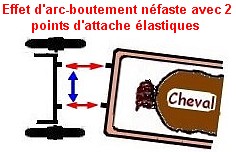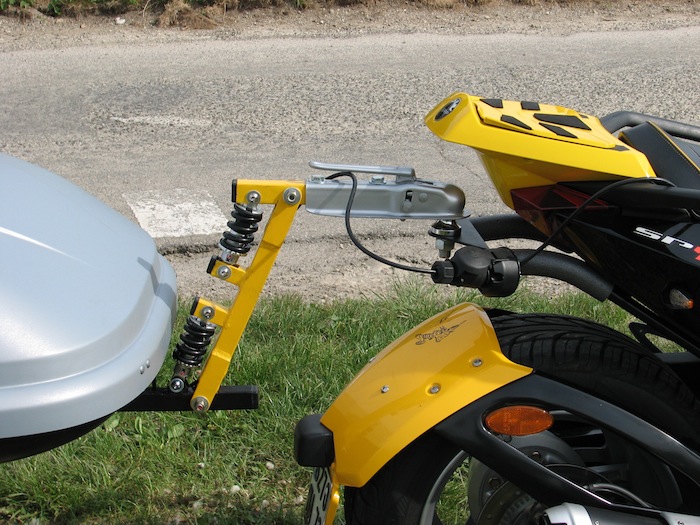I made a small prototype to test a simple system that dampens both traction and compression with a single single spring of any model (traction or compression), the 2 types work very well. I think that the effects, if they are really positive, will be found for the traction of my horse.
I mounted the mechanism on the drawbar of a small trailer and on the towing hook of a small tractor.

(nb: this drawing is only an example for a better understanding!

).
For the moment, I only test with simple and common springs (traction and compression, without oil or air) and I do not observe any resonance phenomenon:
-
When the engine starts, the tractor moves forward, the drawbar of the trailer gradually lengthens a few cm, and as soon as the tension becomes sufficient, the trailer gradually follows,
smoothly noticeable.
-
Braking, the tractor idles and the drawbar of the trailer compresses under the effect of the kinetic energy of the trailer which gradually stops, only retained by the tractor which comes to a stop.
In this case, it's like self-braking trailers except that my trailer has no brake, it's just progressive braking by holding the tractor.
It remains to be seen whether this braking of the trailer is really more effective with this system, in other words, is it more effective when the kinetic energy acquired by the trailer (and absorbed by the spring) is gradually restored to the stopped tractor or moving ?…
For now, the real advantage that I see is the elimination of jolts and "hard" shocks, which already seems good to me to reduce wear and breakage. (I have already twisted and broken my towing hooks and tow bars several times during severe impacts).
It now remains for me to make comparative tests in real and specific situations to see if the system brings real advantages in this mechanical traction and braking.
First by comparing the results with and without the system fitted with a simple spring, then with and without the system fitted with a real shock absorber (oil or air, mountain bike shock absorber type):
- take out a bogged down trailer
- hill start with a heavily loaded trailer
- braking on slippery ground
- starts and brakes with fragile load (eg a bucket full of water)
- Etc. ..
If you have ideas for simple tests, I am interested.
Then I will go to the tests with my horse-drawn equipment.
The ideal would be to make precise measurements of the forces at work, at start-up and at braking to draw comparative curves, but I would need sophisticated measurement equipment.
(I made a short video. If some people want to see what it is, I send you the link by MP.)
Now another mechanical problem arises:
The length of a spring or shock absorber (from 20 cm for a mountain bike cushioning to 40 cm or more for a car) is not easy to insert in the reduced space which separates the tractor from the trailer, or the horse in his charge. Remember the sketch from my first post:

It would therefore be necessary to return the direction of the forces in red in the perpendicular direction indicated by the blue arrow, which would also allow to bring together and concentrate the 2 action points (red) in 1 only (blue):

This would also have the advantage of removing the effect of "
buttressing", that is to say the" break "in the pulling line, for example the problem of a drawer with 2 handles which become blocked when only one handle is pulled.
 I look forward to your ideas, comments and advice on these two points of mechanics! ...
I look forward to your ideas, comments and advice on these two points of mechanics! ...














